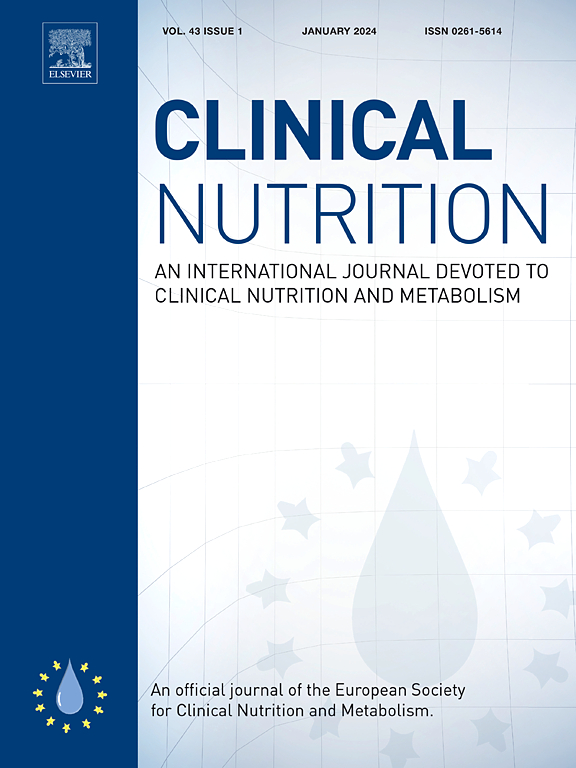肌肉质量介导老年人饮食多样性和死亡率之间的关系:一项前瞻性队列研究
IF 6.6
2区 医学
Q1 NUTRITION & DIETETICS
引用次数: 0
摘要
饮食多样性与死亡风险增加之间的关系是有据可查的。然而,尚不清楚饮食多样性是否以及在多大程度上通过阑尾骨骼肌质量(ASM)影响死亡率。因此,我们评估了ASM是否介导了饮食多样性和死亡率之间的关联。方法采用2011-2018年中国纵向健康寿命调查(CLHLS)数据。基线膳食多样性评分(DDS)来源于9种食品,抗炎膳食多样性评分(AIDDS)用于评估饮食中抗炎食品的多样性。采用Cox回归模型估计DDS和aids与死亡率的关系。相互作用分析分析各组DDS、aids与ASM的相关性。随后,进行中介分析以检验ASM是否部分解释了这种关联。结果共纳入受试者5422人,平均年龄85.99岁。其中3241人在随访期间死亡。我们观察到,DDS (HR = 0.907, 95% CI: 0.842-0.977)和aids评分(HR = 0.947, 95% CI: 0.917-0.977)较高的参与者死亡率较低。亚组分析显示,DDS、aids和ASM之间无交互作用(p为交互作用0.05)。ASM介导了DDS与死亡率之间14.0%的相关性,以及艾滋病与死亡率之间10.7%的相关性。结论膳食多样性和抗炎膳食多样性可降低老年人死亡风险,促进长寿。这些因素之间的关联部分是由老年人肌肉量的增加所介导的。本文章由计算机程序翻译,如有差异,请以英文原文为准。
Muscle mass mediates the association between dietary diversity and mortality among the older adults: A prospective cohort study
Aims
The association between dietary diversity and increased mortality risk is well-documented. However, it remains unclear whether and to what extent dietary diversity affects mortality through appendicular skeletal muscle mass (ASM). Therefore, we assessed whether ASM mediated the association between dietary diversity and mortality.
Methods
We used data from the Chinese longitudinal healthy longevity survey (CLHLS) (2011–2018). The baseline Dietary Diversity Score (DDS) was derived from 9 food items, and the Anti-inflammatory Dietary Diversity Score (AIDDS) was used to assess the diversity of anti-inflammatory foods in the diet. Cox regression models were employed to estimate the association of DDS and AIDDS with mortality. Interaction analysis was performed to analyze the association between DDS, AIDDS, and ASM in different groups. Subsequently, mediation analysis was performed to examine whether ASM partly accounted for the association.
Results
A total of 5422 participants (average age 85.99 years) were included in the analysis. Among them, 3241 participants died during the follow-up period. We observed that participants with higher DDS (HR = 0.907, 95 % CI: 0.842–0.977) and AIDDS scores (HR = 0.947, 95 % CI: 0.917–0.977) had lower mortality rates. Subgroup analyses showed no interaction between DDS, AIDDS, and ASM (p for interaction>0.05). ASM mediated the 14.0 % association between DDS and mortality, and the 10.7 % association between AIDDS and mortality.
Conclusions
Dietary diversity and anti-inflammatory dietary diversity could reduce mortality risk and promote longevity in older adults. The association between these factors was partially mediated by an increase in muscle mass among older adults.
求助全文
通过发布文献求助,成功后即可免费获取论文全文。
去求助
来源期刊

Clinical nutrition
医学-营养学
CiteScore
14.10
自引率
6.30%
发文量
356
审稿时长
28 days
期刊介绍:
Clinical Nutrition, the official journal of ESPEN, The European Society for Clinical Nutrition and Metabolism, is an international journal providing essential scientific information on nutritional and metabolic care and the relationship between nutrition and disease both in the setting of basic science and clinical practice. Published bi-monthly, each issue combines original articles and reviews providing an invaluable reference for any specialist concerned with these fields.
 求助内容:
求助内容: 应助结果提醒方式:
应助结果提醒方式:


